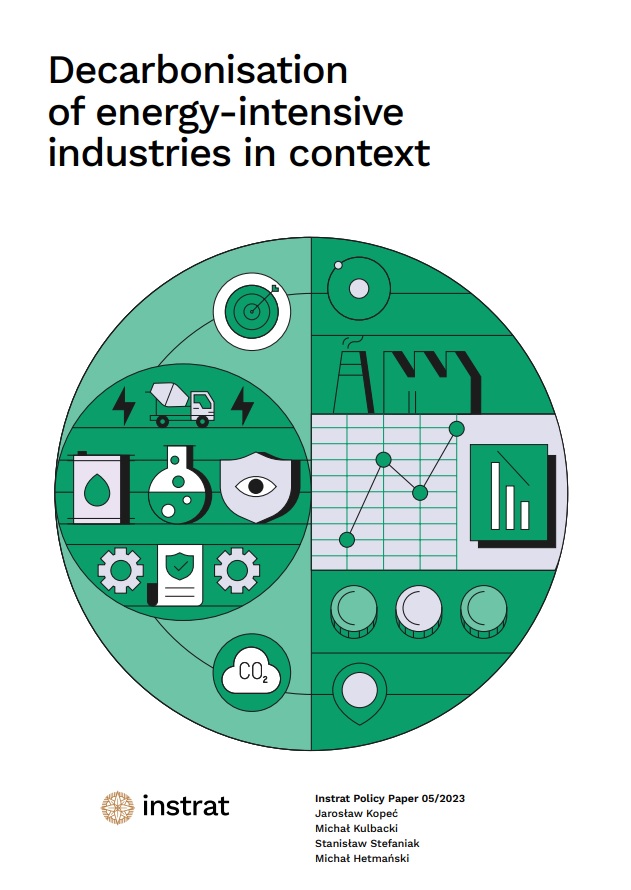Polish industry faces a challenge, but also an opportunity to become a sustainable and competitive part of the global low-carbon economy. Industry decarbonisation is crucial, as just four energy-intensive sectors account for 15% of all CO2 emissions in the country. The energy transition does not mean industrial collapse. On the contrary, Instrat’s economic modelling suggests that both employment and value added in these industries will remain stable.
47 million tonnes of CO2 from 4 sectors
The 4 high-emitting industries are: metal production, cement production, the chemical sector and oil refining and coke production. Together, they account for approximately 47 million tonnes of CO2 emissions per year, which translates into 81% of industrial emissions and 15% of all CO2 emissions in Poland. Their decarbonisation is therefore key to achieving the country’s climate neutrality.
Between 2012 and 2021, the CO2 emissions of energy-intensive sectors fell by only 2.3%. However, the value added generated by these sectors increased by 33.6% during this period. Thus, as a result of improvements in energy intensity and changes in the fuels used, there has been a decoupling of emissions from production volume. This is positive news, but is not tantamount to the decarbonisation of industry, which will require more far-reaching, fundamental changes to the production processes of energy-intensive industries.
A range of technological options
The decarbonisation of each energy-intensive industry poses specific and different challenges. Various technological solutions are also available for most of the energy-intensive industries: electrification, the use of hydrogen, CCS technology or the introduction of process changes. ‘In the report, we take a closer look at the cement manufacturing and steel production industries and show that different decarbonisation options can be identified for each of them. It is necessary to take a sectoral view when talking about industry transformation’, assesses Instrat expert Stanisław Stefaniak.
Decarbonisation of industries in context
Which of the available technological options is optimal for a given sector does not depend only on the decisions of the companies themselves. Equally influential are the public support schemes that form part of the new green industrial policy. Generous subsidies for manufacturers of new low-carbon technologies, as provided for in the Inflation Reduction Act adopted in the United States and under the EU’s Green Deal Industrial Plan, already make green decarbonisation policies key not only to achieving climate goals but also to maintaining economic competitiveness. Traditional energy-intensive industries will benefit indirectly from some of these measures, as recipients of net-zero technologies, and some of the support will go directly into their pockets.
The main tools to support the industry relate to ensuring adequate access to finance. Support from public funds will be crucial for innovative projects based on the implementation of new technologies. Moreover, by adopting sound decarbonisation plans and strategies, energy-intensive companies can improve their access to private financial capital as well.
Regional dimension of the industry going green
In the debate about the greening of industry, the regional context is also important. Currently, most industrial plants are concentrated in the south of Poland, close to coal-based energy sources and raw material deposits. However, with the energy transition, new generation capacity – offshore wind and nuclear – will be located in the north. Along with these, industrial plants may follow, directly encouraged by special energy zones.
So even if, from a national perspective, the balance of industrial decarbonisation is positive, regions currently economically dependent on industrial plants may suffer. ‘In order to minimise the social costs of industrial greening, it is necessary to include industrial regions in the support mechanisms that are used today in post-carbon regions covered by the Just Transition Fund’, says Stanislaw Stefaniak.
Green energy investment shock to support industry
How will the economy be affected by the green investment shock, i.e. the increased investments in the energy transition in the electricity field? The results of macroeconomic modelling carried out by Instrat show that they will increase the value added generated across the economy, including in energy-intensive sectors. The value of this positive impact will gradually increase, peaking between 2040 and 2049. Modelling results from input-output tables, also show that, as a result of the shock, employment in energy-intensive sectors could increase by more than 3,000 workers from as early as 2026. ‘Our calculations show that the energy transition will increase the demand for products produced by energy-intensive industries. It does not mean the deindustrialisation of Poland. Quite the contrary’, assesses the report’s co-author Michał Kulbacki from the Instrat Foundation.
Lessons for the new government
Western Europe is currently pursuing an intensive green industrial policy, providing subsidies for the domestic production of key innovative low-carbon technologies, such as electric batteries or hydrogen technologies. However, it is also necessary to include traditional energy-intensive industries in public aid programmes. ‘Strategic plans adopted by the Polish government to develop specific technologies or to support industry in general should be complemented by sectoral strategies that respond to the unique challenges of each energy-intensive industry. What is at stake is not only the achievement of climate neutrality of the economy, but also ensuring its competitiveness’, concludes Instrat expert.


